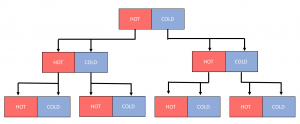
This past week, I listened to multiple people talk about their amazing projects. From using CRISPR/Cas9 to alleviate symptoms of muscular dystrophy to stress between male baboons, I have thoroughly enjoyed hearing about the research my peers are doing.
The one project that really peaked my interest was Sweta’s project titled “Epistability: Transgenerational and Environmental Effects on Plant Development.”
Sweta is looking at early plant development in the model organism Arabidopsis (which she called Dobby) and how the epigenetic changes can be inherited (which is very much a Lamarckian idea). Sweta is looking at the effects temperature has on growth, knowing that Dobby grows better at 22°C compared to 10°C. She has two aims: looking at the stability of the transgenerational effects and looking at the stability of the genotype. She is mainly working on her first aim the summer in which she is looking at 3 generations of plants treated at both hot and cold temperatures (see figure 1). When I asked her what she expects from her data, she said that she expects the parental environment to have the most effect on the offspring compared to the grandparents.
I found this topic extremely interesting because it seems very much like Lamarckian evolution rather than Darwinian evolution. I entirely believe that the environment has a strong effect that can be passed on from parent to offspring, especially after doing a field work experiment with a graduate student in the Donohue lab (the lab Sweta works in) on niche construction as a method to cope with drought. The idea that a phenotype in addition to a genotype can be passed down is very exciting considering we all express genes differently, although we have many of the same genes.
I final thing I was very impressed by was Sweta’s use of the board and presentation because she clearly knew what she was talking about and was able to demonstrate it well using only a section of the already limited space.

